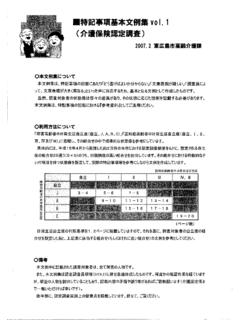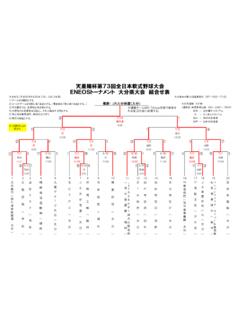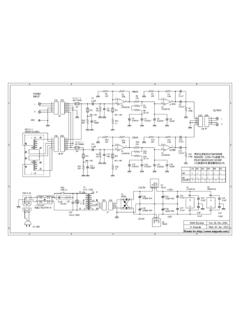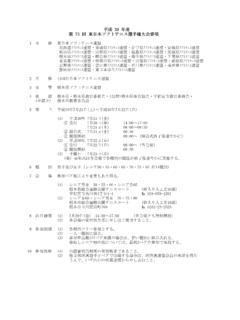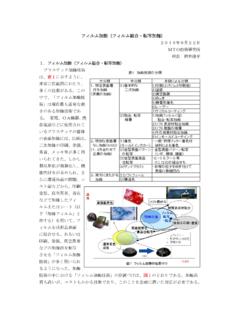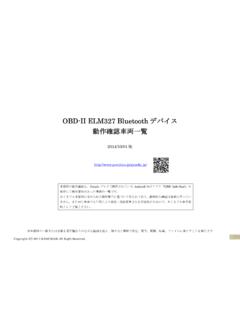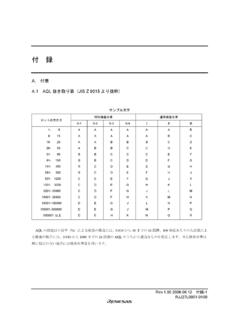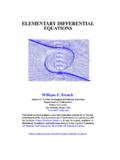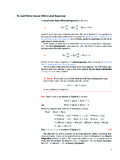Transcription of R. Courant and D. Hilbert METHODS OF …
1 R. Courant and D. Hilbert METHODS OF MATHEMATICAL PHYSICS. Volume II. Partial differential Equations by R. Courant CONTENTS. I. Introductory Remarks S1. General Information about the Variety of Solutions . 1. Examples 2. differential Equations for Given Families of Functions S2. Systems of differential Equations 1. The Question of Equivalence of a System of differential Equations and a Single differential Equation 2. Elimination from a linear System with Constant Coefficients 3. Determined, Overdetermined, Underdetermined Systems S3. METHODS of Integration for Special differential Equations . 1. Separation of Variables.
2 2. Construction of Further Solutions by Superposition. Fundamental Solution of the Heat Equation. Poisson's Integral S4. Geometric Interpretation of a First order Partial differential Equation in Two Independent Variables. The Complete Integral 1. Geometric Interpretation of a First order Partial differential Equation 2. The Complete Integral . 3. Singular Integrals .. 4. Examples S5. Theory of linear and Quasi- linear differential Equations of First order 1. linear differential Equations . 2. Quasi- linear differential Equations . S6. The Legendre Transformation . 1. The Legendre Transformation for Functions of Two Variables 2.
3 The Legendre Transformation for Functions of n Variables 3. Application of the Legendre Transformation to Partial differential Equations S7. The Existence Theorem of Cauchy and Kowalewsky 1. Introduction and Examples . 2. Reduction to a System of Quasi- linear differential Equations 3. Determination of Derivatives Along the Initial Manifold 4. Existence Proof for Solutions of Analytic differential Equations 4a. Observation About linear differential Equations 4b. Remark About Nonanalytic differential Equations. 5. 5. Remarks on Critical Initial Data. Characteristics. Appendix 1 to Chapter I. Laplace's differential Equation for the Support Function of a Minimal Surface Appendix 2 to Chapter I.
4 Systems of differential Equations of First order and differential Equations of Higher order . 1. Plausibility Considerations 2. Conditions of Equivalence for Systems of Two First order Partial differential Equations and a differential Equation of second order II. General Theory of Partial differential Equations of First order S1. Geometric Theory of Quasi- linear differential Equations in Two Independent Variables 1. Characteristic Curves 2. Initial Value Problem 3. Examples S2. Quasi- linear differential Equations in n Independent Variables S3. General differential Equations in Two Independent Variables 1. Characteristic Curves and Focal Curves.
5 The Monge Cone 2. Solution of the Initial Value Problem 3. Characteristics as Branch Elements. Supplementary Remarks. Integral Conoid. Caustics. S4. The Complete Integral S5. Focal Curves and the Monge Equation S6. Examples 1. The differential Equation of Straight Light Rays, (grad u)2 = 1. 2. The Equation F (u x , u y ) = 0. 3. Clairaut's differential Equation 4. differential Equation of Tubular Surfaces . 5. Homogeneity Relation S7. General differential Equation in n Independent Variables S8. Complete Integral and Hamilton-Jacobi Theory 1. Construction of Envelopes and Characteristic Curves 2. Canonical Form of the Characteristic differential Equations 3.
6 Hamilton-Jacobi Theory 4. Example. The Two-Body Problem 5. Example. Geodesics on an Ellipsoid S9. Hamilton-Jacobi Theory and the Calculus of Variations 1. Euler's differential Equations in Canonical Form 2. Geodetic Distance or Eiconal and Its Derivatives. Hamilton-Jacobi Partial differential Equation 3. Homogeneous Integrands 4. Fields of Extremals. Hamilton-Jacobi differential Equation 5. Cone of Rays. Huyghens' Construction, 6. Hilbert 's Invariant Integral for the Representation of the Eiconal 7. Theorem of Hamilton and Jacobi.. S10. Canonical Transformations and Applications. 1. The Canonical Transformation.
7 2. New Proof of the Hamilton-Jacobi Theorem 3. Variation of Constants (Canonical Perturbation Theory). Appendix 1 to Chapter II. S1. Further Discussion of Characteristic Manifolds 1. Remarks on Differentiation in n Dimensions 2. Initial Value Problem. Characteristic Manifolds S2. Systems of Quasi- linear differential Equations with the Same Principal Part. New Derivation of the Theory S3. Haar's Uniqueness Proof Appendix 2 to Chapter II. Theory of Conservation Laws III. differential Equations of Higher order . S1. Normal Forms for linear and Quasi- linear differential Operators of second order in Two Independent Variables.
8 1. Elliptic, Hyperbolic, and Parabolic Normal Forms. Mixed Types 2. Examples. 3. Normal Forms for Quasi- linear second order differential Equations in Two Variables .. 4. Example. Minimal Surfaces. 5. Systems of Two differential Equations of First order S2. Classification in General and Characteristics 1. Notations. 2. Systems of First order with Two Independent Variables. Characteristics 3. Systems of First order with n Independent Variables . 4. differential Equations of Higher order . Hyperbolicity. 5. Supplementary Remarks . 6. Examples. Maxwell's and Dirac's Equations S3. linear differential Equations with Constant Coefficients 1.
9 Normal Form and Classification for Equations of second order 2. Fundamental Solutions for Equations of second order 3. Plane Waves 4. Plane Waves Continued. Progressing Waves. Dispersion 5. Examples. Telegraph Equation. Undistorted Waves in Cables 6. Cylindrical and Spherical Waves S4. Initial Value Problems. Radiation Problems for the Wave Equation 1. Initial Value Problems for Heat Conduction. Transformation of the Theta Function 2. Initial Value Problems for the Wave Equation 3. Duhamel's Principle. Nonhomogeneous Equations. Retarded Potentials 3a. Duhamel's Principle for Systems of First order 4. Initial Value Problem for the Wave Equation in Two-Dimensional Space.
10 Method of Descent 5. The Radiation Problem 6. Propagation Phenomena and Huyghens' Principle S5. Solution of Initial Value Problems by Fourier Integrals 1. Cauchy's Method of the Fourier Integral 2. Example 3. Justification of Cauchy's Method S6. Typical Problems in differential Equations of Mathematical Physics 1. Introductory Remarks 2. Basic Principles 3 Remarks about 'Improperly Posed" Problems 4. General Remarks About linear Problems Appendix 1 to Chapter III. S1. Sobolev's Lemma S2. Adjoint Operators 1. Matrix Operators 2. Adjoint differential Operators Appendix 2 to Chapter III. The Uniqueness Theorem of Holmgren IV.

